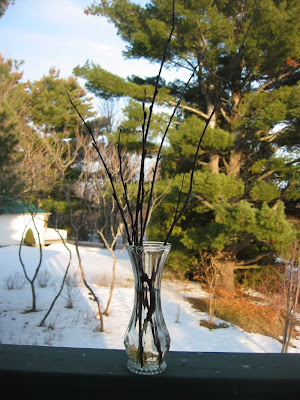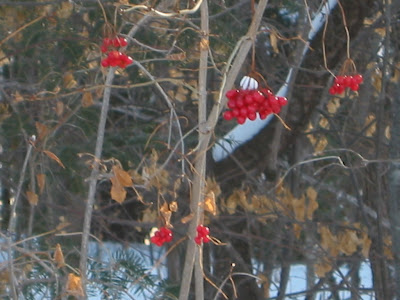
Tuesday, 8:30 AM. 27 degrees, wind NE, gusty. About 1” of snow has already fallen and it is snowing pretty hard. There is a strong low with a blizzard coming in from the NE and it is sucking the weather in off the lake. We were chased by the weather all the way across South Dakota and Minnesota yesterday and are very lucky not to have been caught in this. We were lucky with driving weather the entire trip. It is good to be home, the plants need watering and there is a pile of mail to catch up with. Lucky is glad to be back in his own territory. I hear the wind sled making its runs again now that the ice road is closed, and there are reports of the bears waking up.
We left Denver after lunch on Saturday, and were happy to see son-in-law Doug back in town before we had to leave. We drove only to North Platte and stayed there Saturday night, we went to a local steak house which was unbelievably crowded for hours and hours; no recession in North Platte Nebraska either it looks like. We decided to drive north on US 83 rather than continue on I80 so we did not go to Grand Island to watch cranes, opting to go through the Sand Hills instead. The Sand Hills are one of my absolute favorite places, along with the Kansas Flint Hills. Almost no trees except some cottonwoods and willows in the draws, and the weedy junipers which have been planted as wind breaks and spring up on the prairie. This is tall grass prairie, clothing an undulating sea of sand. If the grass is overgrazed the sand is blown away, so it is almost obligatory not to overgraze; whereas in Texas and New Mexico overgrazing leads to the grass being replaced by mesquite and sage brush and cactus, and that is unfortunately often the case. The Sand Hills are great producers of deer and birds of all kinds, as there are pot holes filled with water which attract migrating waterfowl, and some pretty good streams (the Dismal, White River and branches of the Loupe and some others)and we saw ducks, geese, swans, hawks, turkeys and a few eagles in the several hours it takes to traverse the Sand Hills south to north. I find it difficult to take photographs of this country, as it is one hill and ridge after another, although there are longer vistas here and there. This is prime cattle country and we saw thousands of cows, almost every one with a calf, a good spring for the ranchers. I have never seen an antelope in the Sand Hills, I don’t know why. The Valentine National Wild Life Refuge is in the middle of the Hills, 71,500 acres of grass and prairie potholes. The Niobrara River is the northern boundary of the Sand Hills, which give way to the Dakota high plains to the north, and if followed to the west the Black Hills. I canoed parts of the Niobrara out of Valentine several times, and it is a nice trip. The Sand Hills are drouthy, but soak up water like a sponge, and there is a vast reservoir of water in the Ogalalla aquifer, which underlies much of Nebraska, Kansas and down into the Texas Panhandle. Valentine is a quintessential cow town, that we like a lot. The Niobrara National Wildlife Refuge is here, with buffalo and elk herds one can drive through. We did so some years ago, in a little red car, and the buffalo bulls looked at us with Satanic eyes, and we thought we might be assaulted at any moment. All this is iconic Western landscape, and we love it. We continued north through the Rose Bud Indian Reservation, to I90 and headed home, the gathering blizzard behind us all the way. We stopped for the night in Owatanna Minnesota ( picked up catalogs at the huge Cabela’s outfitters there) and came home via Hwy 63. Nothing had changed much in Wisconsin since we left, except the snow had melted, momentarily.
















































